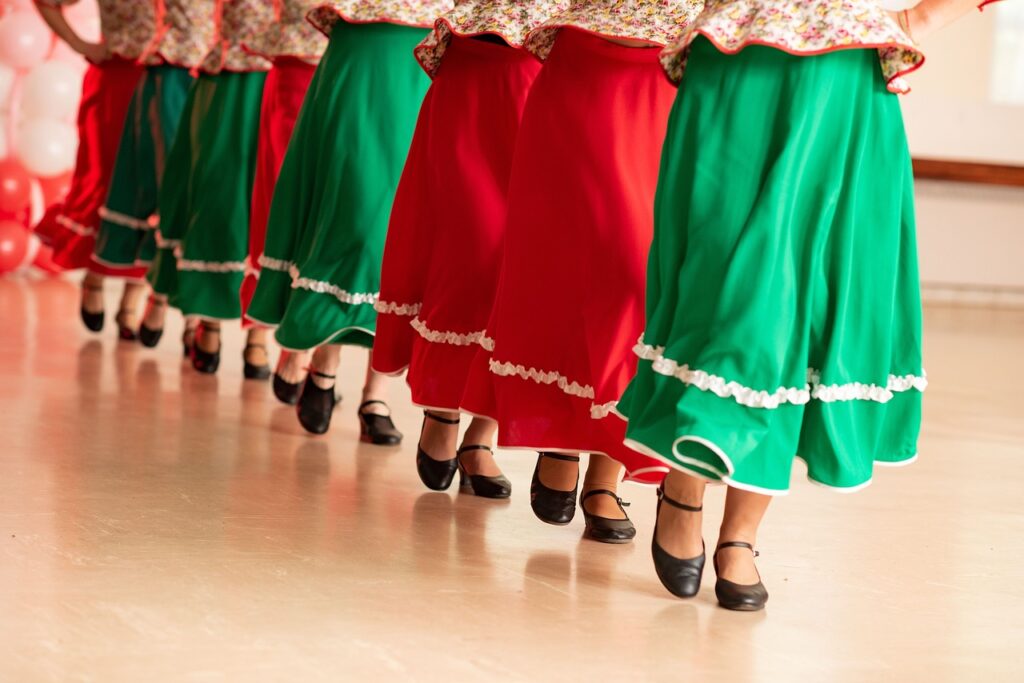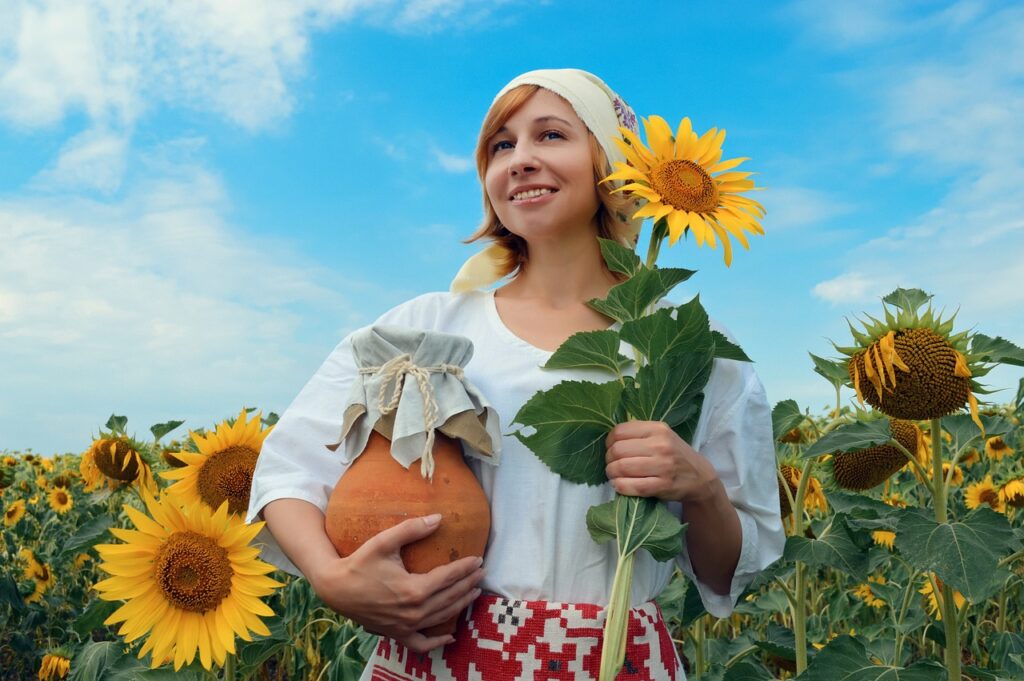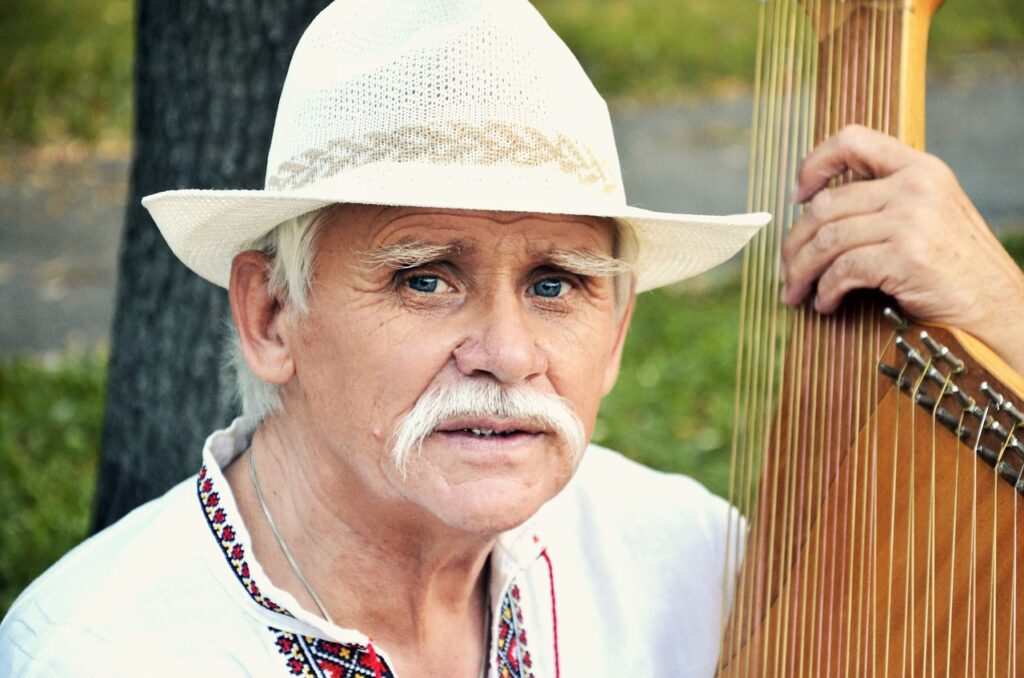There’s a saying that ‘the elegance of traditional wear is timeless; it never goes out of fashion.” Ukrainian Traditional clothing connects us to our cultural roots and fosters a sense of belonging. It portrays a story of love, beauty, and pride.
Just a glimpse at a person in traditional clothing gives you knowledge of their true identity, and you need no one to tell you the values that resonate with them.
Let’s take a cultural trip to the roots of Ukrainian traditional clothing.
About Ukrainian Traditional Clothing

Ukrainian traditional clothing is known as the VYSHYVANKA, which is interpreted as an embroidered dressing. The roots of this traditional clothing trace back to the times of Kievan Rus (10th–12th century).
Ukrainian traditional attire can be divided into two periods: costumes of the Kievan Rus’ epoch (9th–13th) and clothing of the Cossack era (14th–21st).
So, there were two different types of clothing, but they had some similarities (like embroidery, similar pieces of clothing, similar materials, and so on).
In the mid-20th century, folk costume incorporated embroidery designs and was made out of linen, hemp, and wool. Clothes-making was at that time the main economic activity of Ukrainians.
Each pattern of traditional clothing suggested the ethnic background, social status, and marital status of the person.
Traditional Ukrainian clothing has won the hearts of the world’s most fashionable people, therefore making it famous beyond the traditional concept of it.
Today, a large number of Ukrainian embroidered clothes are stored in different museums in the United States of America and Canada due to the mass migration of Ukrainians in the 19th and early 20th centuries.
The reasons for such hype include simplicity in form, a slender silhouette, a variety of emblems and adornments, and the rich colors used for making the clothing.
The main feature of Ukrainian Traditional clothing is the embroidery on the neck, cuffs, and hem. Ukrainian traditional clothing symbolizes beauty, power, happy fate, and family memory.
An unmarried girl is meant to wear a shirt without outerwear, while a married woman has to cover her head with a shawl and augment the outfit with her waistcoat and maxi skirt.
However, the foreground of the clothing is accessories like belts, jewelry, and headdresses (a shawl or a floral wreath), decorated with ribbons and fresh and artificial flowers, not to mention the abundance of beads and ducats (coins), which determine the women’s status.
Ukrainian women paid great attention to their hair. Unmarried girls used to wear their hair loose. They wore ribbons, wreaths of fresh or artificial flowers, leaves, and wheatears. Sometimes they braided their hair in one or two braids.
Married women always hide their hair. They wore different headdresses. The most popular was “ochipok”; this headdress had a lot of different forms. It sits tightly on the head and has a lacing on the back.
Ochipok was made of linen cloth, silk, gold cloth, etc.
Another popular headdress was “namitka”. Women used to wear namitka in many different ways. Ukrainian women often wore different hats, and not only in winter.
There were fur hats, hats made of linen and silk.
Men’s traditional clothing is simpler: they resemble the outfits of other Slavic nations but differ in the way they are worn.
Hence, there are two main elements: a linen shirt and cloth pants, distinguished by the kind of embroidery.
10 Ukrainian Traditional Clothing
These Ukrainian Traditional clothing are distinguished by the type of women’s lower body garment. The base, or foundation garment for all of these is the chemise(a loose straight-hanging dress), or sorochka.
Traditionally, the sorochka hem was visible below the lower body garment.
This was originally ankle length and usually embroidered on the shoulder, upper sleeve, collar, cuffs, and often the hem. In more recent years, there has been a tendency to cut the chemise in half and make the lower part into a detached garment.
1. Plakhta
The costume with plakhta was popular in central, eastern, and southern Ukraine, from about Cherkassy to the east. It had the same origin as the Russian poneva [paniova].
It is a woven rectangle of cloth wrapped around the hips from the back, leaving a gap in front. Both have a woven checkerboard pattern.
In Russia, this pattern is very simple, usually consisting of white lines on a black background. The poneva is further ornamented with woven cloth sewn to the edge, or with ribbons and balloons sewn on, and even with stripes of embroidery.
The top of the plakhta may be folded over and sewn into a tube with a drawstring strung through it, like the poneva, but often two long pieces are sewn together side by side, as seen above, for a bit more than half its length. The plakhta is folded over a sash tied around the waist, and the upper half falls over the lower.
This is called plakhta with wings and is the original form.
The Ukrainian plakhta is equally highly ornamented but in a unique way. The individual squares or rectangles of the cloth have designs woven in, the colors varying from one square to the next.
2. Obhortka
The obhortka is also sometimes called ‘horbotka’, ‘fota’, ‘opynka’, or ‘derka’. ‘Obhortka’ means ‘that which is wrapped around’. This consists of a rectangle of heavy cloth that is wrapped around the hips from behind, overlaps in front, and is held in place by a sash.
This is found in Podillia, Pokuttia, Bukovyna, Bessarabia, and also in Eastern Romania; Moldavia, and Muntenia.
The Obhortka also has woven ornament, but generally fine lines vertically, and also around the edges. The base color is often black, but in eastern Pokuttia it is brick red.
This garment is often worn with one or both corners pulled up and tucked into the waist. It is usually worn without an apron, but in some regions, an apron is worn.
In central Ukraine, a simple wrap-around skirt called derka was often worn as working attire.
3. Costume With a Single Apron
While it often happened that women working in the fields would wear just a chemise and apron, the single apron traditional clothing was worn as dress attire only in the central lowlands of Transcarpathia, in the regions around Irshava and Khust, and as far east as Teresva.
In the Khust region, the apron is very wide, going almost around the waist, and is called a plat.

4. Skirt and Bodice
This traditional clothing is found in odd islands in southern Podillia and eastern Polissia in Ukraine. It is variously called talijka, riklia, or sharafan. It is a bodice with an attached skirt.
This type of traditional clothing is common in Western Europe Scandinavia, Bulgaria, and among some of the Hungarians in Mezoseg, Transylvania.
None of these appears to be a likely source for this garment appearing in sporadic places in Ukraine.
Toporivtsi, Bukovyna. In this village, this traditional garment is called riklia. It was once more popular in Bukovyna but now appears only in this one village as part of the wedding costume.
In other parts of Bukovyna, the bodice has disappeared and the gathered skirt is called riklia by itself.
5. A woven or Plaited Woolen Belt.
This was a mandatory item of Traditional Ukrainian national clothing. It performed the function of affixing the belted cloths, and it was also given a great symbolic value.
In some mountainous regions, men’s leather belts called ‘Cheres’ which had from one to six buckles and were decorated with metal chains and buttons were popularly used.
6. Svyta
This is a kind of overgarment. Svyta looked like a modern coat (it has many variations), was made of wool and majorly it was white. Another kind of overgarment used by the Ukrainians is the Kobenyak(a coat). It was rather wide because men often wore it over the other outerwear.
7. Panyova
This is a part of women’s wear, mainly for married women. It looked very much like an apron, but it was worn with a cut in front.
8. Zapona or Zanaviska
Unmarried women wore this piece of traditional clothing on top of a shirt. It looks like a dress without sleeves and is cut into 2 parts from the waist to the bottom. It was belted too.
Zapona was majorly used by women in Kievan Rus. The clothing of noble people in Kievan Rus’ was beautified with embroidery (this tradition is still preserved in Ukraine), fur, precious metals, gems, and different patterns on fabric.
9. Porty
This was worn by men in Kievan Rus. This traditional clothing can be described as a knee-length shirt always worn with a belt and tight pants.
The shirt had very long sleeves to replace mittens. While working men had pumped sleeves. Shirts and pants were made of homespun cloth.
10. Sharovary
Sharovary is a kind of very wide trousers, belted on the waist and gathered at the bottom near the ankles. It is made of colored cloth, percale, or silk.
Ukrainian Cossacks wore sharovary because they were considered to be the most convenient pants. Usually, they are red or blue. Men wore sharovary either with the shirt tucked into it or narrow trousers with the shirt untucked.
It was also discovered during the second world war, people buried their clothes in the ground to preserve the priceless national heritage of embroidery from the Soviet and the German occupiers.
After the end of the world war, the traditional embroidered clothes became a manifestation of belonging to the Ukrainian nation worn by writers, politicians, activists, and journalists.
Traditional Ukrainian clothing became a source of inspiration for many international luxurious brands such as Gucci, Dolce & Gabbana, Jean-Paul Gaultier, John Galliano, and many others.
Final Words
Ukrainians believe embroidery(Vyshyvanka) has a talisman meaning —the power to protect a person from all harm and bring good luck. Also, it can work miracles. Hence, why it is very much treasured.
Traditionally, there are six main colors of Ukrainian traditional clothing embroidery: white, black, red, blue, yellow, and green, each with its significance.
Red and black are the most commonly used colors in Vyshyvanka patterns. Red is considered to represent luck, joy, and love. Black, contrary to its association with sorrow, symbolizes wisdom in Ukrainian embroidery.
The color black is also said to symbolize Ukraine’s fertile soil. In some regions, this traditional embroidery (vyshyvankas) was decorated with black ornaments for weddings to wish the couple wealth and a strong marriage.
The color white in Ukrainian traditional clothing is associated with purity, innocence, and holiness. Vyshyvankas with blue embroidery were traditionally worn by men, especially those going to war, as the color blue is considered a kind of amulet that protects against diseases and brings peace of mind.
Yellow represents the color of the sun and wheat, symbolizing abundance, joy, and well-being. The color green symbolizes spring and youth.
Ukrainians in recent times wear traditional clothing on special occasions such as national holidays or weddings. They are also worn to celebrate the Day of Vyshyvanka every third Thursday of May.
This holiday is aimed at preserving Ukrainian culture and folk art.



